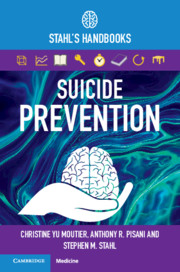Book contents
- Suicide Prevention
- Suicide Prevention
- Copyright page
- Contents
- Acknowledgements
- Section 1 Suicide Prevention Overview
- Section 2 Clinical Risk Assessment and Care
- 5 Collaborative Connections
- 6 Prevention-Oriented Suicide Risk Assessment
- 7 Responding to Suicide Risk
- 8 Extending the Impact of Interventions
- 9 Use of Medications in Suicide Prevention
- 10 Suicide Prevention in Healthcare Systems
- Section 3 Special Topics: Medicolegal Considerations and Specific Populations
- Appendix Resource List
- Index
- References
9 - Use of Medications in Suicide Prevention
from Section 2 - Clinical Risk Assessment and Care
Published online by Cambridge University Press: 15 May 2021
- Suicide Prevention
- Suicide Prevention
- Copyright page
- Contents
- Acknowledgements
- Section 1 Suicide Prevention Overview
- Section 2 Clinical Risk Assessment and Care
- 5 Collaborative Connections
- 6 Prevention-Oriented Suicide Risk Assessment
- 7 Responding to Suicide Risk
- 8 Extending the Impact of Interventions
- 9 Use of Medications in Suicide Prevention
- 10 Suicide Prevention in Healthcare Systems
- Section 3 Special Topics: Medicolegal Considerations and Specific Populations
- Appendix Resource List
- Index
- References
Summary
For which patients does this guidance apply? These principles should be applied in clinical decision making for a broader group of patients than just those with expressed suicidal ideation. Suicide risk includes any patients with elevated risk, many of whom do not present with a chief complaint of suicidal ideation. Their risk may be identified by a recent suicide attempt, or by a family history of suicide along with current psychosocial stressors, or the patient facing a life transition or loss along with deterioration in clinical status. (See Suicide Risk Assessment in Chapter 6). At the broadest level, current clinical standards (including those of The Joint Commission which is based in the USA but accredits health systems in the USA and internationally) consider all patients being treated in behavioral healthcare settings (psychiatric inpatient and outpatient care, psychological therapy, substances use disorder treatment, etc.) as having potentially elevated suicide risk.
- Type
- Chapter
- Information
- Suicide PreventionStahl's Handbooks, pp. 149 - 170Publisher: Cambridge University PressPrint publication year: 2021

